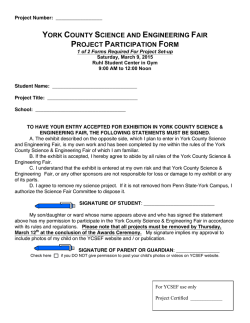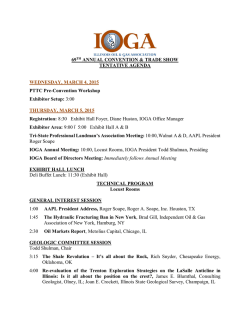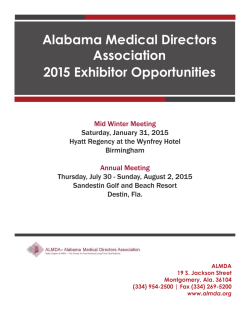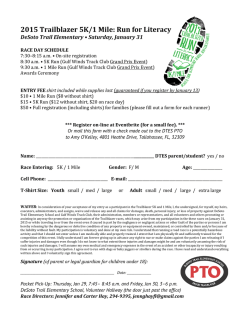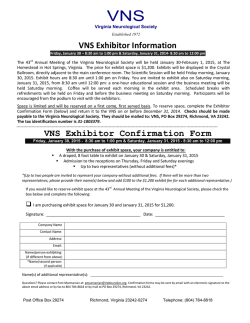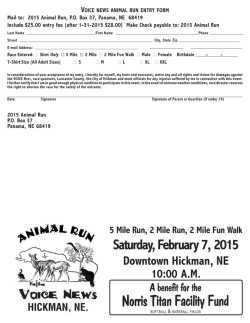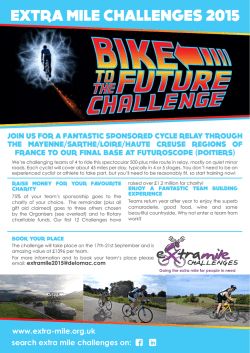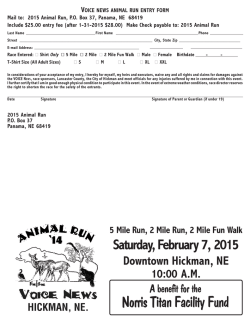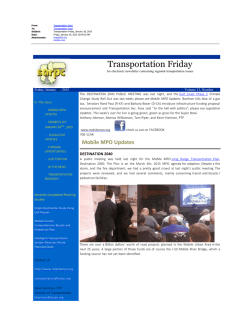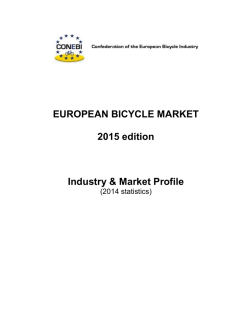
FY 2015 TAP-DA Project Submittal Guide
Wilmington Urban Area Metropolitan Planning Organization Transportation Alternatives Program-Direct Attributable Project Submittal Guide Fiscal Year 2015 – 2nd Call Date of Release: February 2, 2015 MANDATORY Pre-application Review Meeting: March 2, 2015 Electronic Application Submittal Deadline: 5 pm April 3, 2015 Submit one CD to: WMPO 305 Chestnut Street, Fourth Floor Wilmington, NC 28401 CD should be labeled with the following: Project Name Name of Government Agency Requested Funding Source Date 1 Table of Contents Introduction …………………………………………………………………………………………………………… 3 Eligibility Criteria ...................................................................................................... 4 Program Administrative Details ............................................................................... 5 Application Materials .............................................................................................. 6 Map of Project ............................................................................................. 6 GIS File of Project ........................................................................................ 7 Funding Request Submittal Form - Background Information ....................... 7 Funding Request Submittal Form – Bike/Ped Improvements….................... 8 Signed Resolution of Support…………………………………………………………………… 13 Supporting Documents……………………………………………………………………………… 13 Exhibits Exhibit A – Map of Proposed Project……………………………………………………………….. 14 Exhibit B – Closing a Gap Map…………………………………………………………………………. 15 Exhibit C – Sample Resolution…………………………………………………………………………… 16 Exhibit D – Proximity of a School Map………………………………………………………………. 17 Exhibit E – Bicycle and Pedestrian Generator Map………………………………………….. 18 2 Introduction Moving Ahead for Progress in the 21st Century (MAP-21) created the Transportation Alternatives Program (TAP). Pre Map-21 programs including Transportation Enhancements, Recreational Trails, Safe Routes to School and several other discretionary programs have been wrapped into this single funding source. TAP now includes the following: • Construction, planning, and design of on-road and off-road trail facilities for pedestrians, bicyclist, and other nonmotorized forms of transportation. • Construction, planning, and design of infrastructure-related projects and systems that will provide safe routes for non-drivers, including children, older adults, and individuals with disabilities to access daily needs. • Conversion and use of abandoned railroad corridors for trails for pedestrians, bicyclists, or other nonmotorized transportation users. • Community improvement activities, including o Inventory, control, or removal of outdoor advertising; o Historic preservation and rehabilitation of historic transportation facilities; o Vegetation management practices in transportation rights-of-way to improve roadway safety, prevent against invasive species, and provide erosion control: o Archaeological activities relating to impacts from implementation of transportation project eligible under 23 USC. • Any environmental mitigation activity, including pollution prevention and pollution abatement activities and mitigation to o Address stormwater management, control, and water pollution prevention or abatement related to highway construction or due to highway runoff: o Reduce vehicle-caused wildlife mortality or to restore and maintain connectivity among terrestrial or aquatic habitats. • Recreations trails program under 23 USC 206. • Safe Routes to School program under § 1404 of SAFETEA-LU. • Planning, designing, or constructing boulevards and other roadways largely in right-ofway of former Interstate System routes or other divided highways. As a Transportation Management Area (TMA), the Wilmington Urban Area Metropolitan Planning Organization (WMPO) will receive a direct allocation of $222,151.50 in TAP funding annually. This direct allocation is referred to by the WMPO as Transportation Alternative Program Direct Attributable (TAP-DA). A competitive process has been adopted to determine which projects are funded. Due to the variety of projects and the small amount of money, the Transportation Advisory Committee (TAC) gave direction to use the funding for bike/ped projects using the existing Surface Transportation Program – Direct Attributable (STP-DA) bike/ped process for determining fiscal year 2015 (FY 2015) projects. Each jurisdiction is able to submit one project of not less than $50,000 for possible award. The WMPO will provide an initial screening for completeness of application at a MANDATORY pre-application meeting. The draft application meetings will be held on March 2, 2015. Contact WMPO to set up meeting time. 3 Eligibility Criteria In order to be eligible for Transportation Alternatives Program – Direct Attributable (TAP-DA) funding, a project must meet the minimum criteria outlined in this section. Also, a completed application must be submitted by the applicant(s). Co-applications can be submitted by a combination of municipalities in a primary applicant and secondary applicant format. Incomplete applications will not be considered. These criteria meet federal and state funding requirements, as well as the goals of the WMPO for TAP-DA dollars as adopted by the Transportation Advisory Committee (TAC). Projects that do not meet these criteria will not be considered for funding. 1) Federal Aid Eligible Projects The federal eligibility requirements associated with Transportation Alternative Program funding can be found in 23 USC §213 (http://www.fhwa.dot.gov/map21/guidance/guidetap.cfm) 2) Locally Administered By submitting a project for TAP-DA funding, the municipality(ies) or local government entity(ies) are committing funds to sponsor said project. The applicants (if awarded) shall be responsible for all federal and state reporting requirements associated with TAP-DA funding. The local government entities are also expected to make progress reports to the TAC upon request. An inter-local agreement between the North Carolina Department of Transportation (NCDOT) and the designated recipients will outline a reimbursement schedule; local sponsors will be required to front all project costs, invoice NCDOT, and then get reimbursed for the federal percentage dedicated to the project. The WMPO may assist in coordination between NCDOT and the local government entities, however, the ultimate responsibility and the signatories on the NCDOT agreements will be the local government entities. 3) Compliant with the adopted MTP/LRTP Projects must be identified in the WMPO’s current and adopted Metropolitan Transportation Plan/Long-Range Transportation Plan (MTP/LRTP). If desired projects are not identified in the adopted MTP/LRTP at the submittal stage, the MTP/LRTP must be revised before projects are prioritized. In accordance with federal guidelines, the MTP/LRTP must remain fiscally constrained. The TAC must approve any modifications. 4) Locally funded with funding commitment All funds programmed with TAP-DA dollars require a minimum 20% local cash match. This must be demonstrated by attaching a signed copy of the resolution of support authorizing the local government to apply and provide financial support for the project. If an application is a primary/secondary applicant 4 format, a resolution by all parties involved must be submitted with the application. Applications will be considered incomplete without a signed resolution committing financial support. In addition to the provision of the match commitment submitted as part of the TAP-DA application, local government entities are responsible for funding cost overruns on projects in excess of the final programmed cost estimate. This provision may only be waived through the approval for additional funding from TAC and through additional Surface Transportation Improvement Program (STIP) amendments by the Board of Transportation if needed. 5) Transportation Improvement Program (TIP) Projects not in compliance with an existing TIP category will require a TIP amendment. Applicants should consider that the TIP amendment process could delay the funding obligation timeline. 6) Project Design Intent Project design intent must meet Federal and State guidelines. 7) Project Cost Minimum amount requested will be $50,000. Total Cost of Project = Total STP-DA funding requested from TAC + Total Local Match For example, if $50,000 is requested, the minimum local match will be $10,000 for a minimum total project cost of $60,000. Program Administrative Details 1) Project Submittal Limits For FY 2015, the maximum number of project submittals allowed per jurisdiction is one. 2) No Unfunded Project Carry-Over Projects submitted in FY 2015 that are not prioritized for TAP-DA funding are not automatically considered for funding in subsequent years. Any unfunded project may be resubmitted in subsequent years for funding. 3) Construction Requirement within 10 years As a federal funding source, the use of TAP-DA funds must result in achieving Construction Authorization of the project within 10 years of the fiscal year when Preliminary Engineering was authorized. As a result, projects that have cost 5 overruns must be accounted for through a commitment of local funds through the construction phase. This provision may only be waived by the approval for additional funding from TAC and through additional STIP amendments by the Board of Transportation if needed. Application Materials Applicants are required to submit the following materials with their application: 1) 2) 3) 4) 5) 6) Map of project (See Exhibit A for an example) GIS file of project Funding Request Submittal Form – Background Information Funding Request Submittal Form – Bicycle and Pedestrian Improvements Signed resolutions of support from local government to apply and provide financial commitment (See Exhibit B for an example) Supporting documents – Pictures with labels, additional maps, resolutions adopting plans that specify a need for the project, etc. (Resolutions supporting plan must have been adopted prior to call for projects) Details and descriptions of these required materials are supplied in the sections to follow. 1) Map of Proposed Project – See Exhibit A This map is required with all applications. On an 8.5 x 11 or 11 x 17 sheet of paper include the following: a. Full extent of proposed project b. Inset vicinity map – use your jurisdictions boundary c. ½ mile buffer around proposed project drawn in BLACK d. Existing roadways drawn in GREY e. Proposed project drawn in RED DOTTED LINE (linear projects) or RED CIRCLE (intersection or point projects) f. Existing sidewalk drawn in BLUE g. Existing bike lanes drawn in YELLOW h. Existing greenway/multi-use path drawn in GREEN i. Existing bus stop drawn as PURPLE STAR j. Existing crosswalks (improved intersections) drawn as ORANGE CIRCLE k. Major obstacle drawn in BROWN (refer to #2 in application) l. Title m. Legend n. North Arrow o. Scale 6 p. Length of project (if applicable) Note: if you are suggesting the proposed project should receive points for providing a new connection over a major obstacle (#2 in application) or connecting to transit (#10 in application), be sure to illustrate this on this map. 2) GIS File of Project Submit a GIS file geodatabase for your project that meets the following specifications: • Projection= NAD_198_StatePlane_North_Carolina_FIPS_3200_Feet • File Geodatabase for submittal of multiple files for a single project to include .mxd files and associated data • Reasonable and concise metadata must be documented for all files submitted to include: Date of data creation Entity that created data Length of data validity (expiration date) Process for deriving data Metadata should be documented in the file’s metadata tab 3) Funding Request Submittal Form – Background Information The following descriptions of items are to help describe how you should complete this form: Project Phase – Choose the phase of the project that is to be completed next. Project Name – A descriptive name of your project. Project Location – The physical location of the proposed project (typically the jurisdiction or area name). TIP ID# - In the case that your project is for work on a project that is already in the TIP, include the TIP number here. Total Project Cost – An estimate of the total cost of the project for all phases needing completion (Design/NEPA, Right-of-Way, Construction). Note that local jurisdictions are responsible for 100% of actual project costs exceeding the estimations programmed through this process into the STIP (unless otherwise approved by the TAC). Local match and requested funding should be broken out. Total TAP-DA funding requested from TAC = Total Cost of Project – Total Local Match 7 Sponsoring Agency – The name of your agency. Managing Agency – The managing agency will typically be the sponsoring agency; in some cases, however, local governments could partner with NCDOT or the WMPO to have the Division office or the WMPO staff administer a project. Coordination would be required in advance of project submittal in cases where the local jurisdiction requests assistance from NCDOT or the WMPO. Contact Person – This is the person WMPO staff will contact with questions regarding the application. Project Description – A specific description of your project, including beginning and end points of the project and specific facility type. Problem Statement – This can be thought of as a preliminary Purpose & Need Statement used to justify expenditure of funds to address a problem in a WMPO member jurisdiction. The problem statement should state the transportation problem to be solved as well as a minimal amount of data needed to support the problem statement. LRTP Status – Insert the page number where the project is referenced in the current LRTP. If the project is not in the current LRTP, check the corresponding box. 4) Funding Request Submittal Form – Bicycle and Pedestrian Improvements The following descriptions of items are to help describe how you should complete this form. Who will maintain this project after completion? – Identify the entity that will be responsible for maintenance of a project after construction is completed. The responsible party is most likely the sponsoring agency and may, in a few cases, be the managing agency. Project Readiness – Is the project in following stage of completion: Environmental Investigation/Permitting – Project is in the stages of Environmental documentation and/or permitting stage. Design/Survey/Construction Documents – Project has or is in the process of surveying or construction document preparations. ROW acquisition – Project is in the stages of Right-Of-Way acquisition. 8 Bid Phase – Project has been/or is in the process of obtaining construction bids. Partial Construction – Project has started construction or has been awarded and initial contract has been executed. Closing a gap – Choose one of the following choices on the sheet: Closing a gap in total facility length>2 miles - Select if project “fills in a gap” between two net-works or parts of the same network that, should the project be completed, would form a network of over 2 miles in continuous length. Closing a gap in total facility length>0.5 miles- Select if project “fills in a gap” between two networks or parts of the same network that, should the project be completed, would form a network of over 1/2 mile in continuous length. Providing an extension making total facility length>2 miles - Select if project is an addition to an endpoint of an existing facility to create, upon completion of the project, a total continuous facility length of over 2 miles. No gap and proposed total facility length < 2 miles - Select if project will not share an endpoint with an existing bicycle or pedestrian facility. Link Explanation – If the project is considered a missing link, as described above, use this space to detail the beginning and end points of the total facility created by the project MAP: If you are suggesting the proposed project should receive points for closing a gap, a separate map is required. On an 8.5 x 11 or 11 x 17 sheet of paper include the following: a. Full extent of proposed project b. Inset vicinity map – use your jurisdictions boundary c. ½ mile – 2 mile buffer around proposed project drawn in BLACK d. Existing roadways drawn in GREY e. Proposed project drawn in RED DOTTED LINE (linear projects) or RED CIRCLE (intersection or point projects) f. Only include the existing facility that your project will be closing a gap: a. Existing sidewalk drawn in BLUE b. Existing bike lanes drawn in YELLOW c. Existing greenway/multi-use path drawn in GREEN d. Existing crosswalks (improved intersections) drawn as ORANGE CIRCLE g. Title h. Legend i. North Arrow j. Scale 9 k. Length of project (if applicable) See Exhibit C for an example of a ‘Closing a Gap’ Map. Major Obstacle – Choose one of the following choices on the sheet: High – Select if the project creates a new connection across a river, railroad or limited-access multi-lane freeway. Medium - Select if the project creates a new connection across a roadway containing four or more lanes. None - Select if neither of the above apply to this project. NOTE: If a major obstacle is present it should be shown on the Map of Proposed Project – see Exhibit A for an example. Safety Concern – If there are any, report the number of documented bicycle and pedestrian crashes within the past 5 years. This must be a TEAAS report and within approximately ½ mile of the proposed facility. Goat Path – Choose “Yes” where existing use can be demonstrated in the absence of a facility through documented evidence such as a clearly worn path. Adopted in Plan – Choose “Yes” where the specific project has been adopted in a plan by resolution. If yes, list the name of the plan in the space provided and attach a copy of the signed resolution. Plan must have been adopted prior to September 16, 2013. Local Match – The minimum local match required on all TAP-DA projects is 20%. Projects will receive additional points during prioritization for having 30% or more of total project cost provided in local match. Note that, while cost estimates may change throughout the life of a project, the percentage of the local match determined for the purposes of this criteria is based on the cost estimated at the time prioritization is complete for the fiscal year. Provide the amount of local match as well as the requested amount of funds. A signed resolution on letterhead including a commitment of funds is required for the application to be complete. Resolution must specifically include the financial commitment. See Exhibit C for an example of a resolution. Cost of NEPA/Design Phase – Provide an estimate of the total cost of the NEPA/Design Phase. This estimate should include the cost for environmental documentation, permitting, and preliminary engineering. Note that the sum of the three phase-specific cost estimates (NEPA/Design, Right-of-Way, and Construction) should equal the “Total Cost of Project”. 10 Cost of Right-of-Way Phase – Provide an estimate of the total cost of the Right-of-Way Phase. This estimate should include the cost for acquisition of right-of-way and utility relocation. Note that the sum of the three phase-specific cost estimates (NEPA/Design, Right-of-Way, and Construction) should equal the “Total Cost of Project”. Cost of Construction Phase – Provide an estimate of the total cost of the Construction Phase. This estimate should include the cost for materials, construction and inspections of the project. Note that the sum of the three phase-specific cost estimates (NEPA/Design, Right-of-Way, and Construction) should equal the “Total Cost of Project”. Total Cost of Project – Provide the estimate that was provided on the Background Information form. Total Cost of Project = Total TAP-DA funding requested from TAC + Total Local Match Proximity of a School – Indicate if a project is within ½ mile, 1 mile or 1.5 miles of each school type. If you are suggesting the proposed project should receive points for proximity of a school, a separate map is required. On an 8.5 x 11 or 11 x 17 sheet of paper include the following: a. b. c. d. e. f. g. h. i. j. k. Full extent of proposed project Inset vicinity map – use your jurisdictions boundary ½ mile – 1.5 mile buffer around proposed project drawn in BLACK Existing roadways drawn in GREY Proposed project drawn in RED DOTTED LINE (linear projects) or RED CIRCLE (intersection or point projects) Schools located within the ½ mile, 1 mile and 1.5 mile buffer in PURPLE. Title Legend North Arrow Scale Length of project (if applicable) See Exhibit D for an example of a ‘Proximity of a School’ Map. Bicycle/Pedestrian Generators – Indicate if projects are within ½ mile of each of the following facility types as determined by their current tax assessment-based land use code: residential, public park/playground/recreation center, shopping/retail & services, public library, or business park/office/hospital. If you are suggesting the proposed project should receive points for closing a gap, a separate map is required. On an 8.5 x 11 or 11 x 17 sheet of paper include the following: 11 a. b. c. d. e. f. g. h. i. j. k. Full extent of proposed project Inset vicinity map – use your jurisdictions boundary ½ mile buffer around proposed project drawn in BLACK Existing roadways drawn in GREY Proposed project drawn in RED DOTTED LINE (linear projects) or RED CIRCLE (intersection or point projects) Only include the bicycle/pedestrian generators within ½ mile of the proposed facility: a. Public Park/Public Playground/Recreational Area drawn in GREEN b. Residential Areas drawn in BLUE c. Shopping/Retail Areas drawn in YELLOW d. Library drawn in PINK e. Business Park/Office/Hospital drawn in ORANGE Title Legend North Arrow Scale Length of project (if applicable) See Exhibit E for an example of a ‘Bicycle and Pedestrian Generator’ Map Connection to Transit – Indicate if the project provides a direct bicycle or pedestrian connection to an adopted Cape Fear Public Transit Authority bus stop or a park & ride lot. This should be shown on the Map of Proposed Project (see Exhibit A). Note: To receive points, the proposed project must directly connect to a bus stop or a park and ride lot. A project will not receive points for being within a ½ mile of a bus stop or a park and ride lot. WMPO Parallel Functional Classification – Indicate the associated functional classification of the parallel roadway as adopted by the WMPO. (http://www.ncdot.gov/doh/preconstruct/tpb/FCS/) Right-of-Way/Easement Dedication and Utility Relocation - Choose one of the following choices on the sheet: No additional right-of-way and no major utility relocations needed – Select if no additional right-of-way or major utility relocations are required. Minimal additional right-of-way and no major utility relocations needed – Select if right-of-way is required from 2 or fewer property owners and major utility relocations are not required. Significant additional right-of-way needed – Select if right-of way is required from 3 or more property owners. 12 Major utility relocations needed – Select if major utility relocations will be needed for project. Competitive Process Project Readiness Closing A Gap Major Obstacle Safety Concern Goat Path Adopted in Plan Local Match Proximity of a School Bicycle/Pedestrian Generators Connection to Transit WMPO Parallel Function Class Right-of-Way/Easement Dedication and Utility Relocation TOTAL /5 /5 /5 /10 /5 /15 /15 /23 /25 /10 /7 /10 /135 5) Resolution of Support Resolution must be on letterhead and signed for application to be considered to be complete. Resolution must include a specific amount of committed matching funds. See Exhibit C for an example resolution. 6) Supporting Documents Pictures with labels, additional maps, resolutions adopting plans that specify a need for the project, etc. (Resolutions supporting plan must have been adopted prior to call for projects) 13 Exhibit E Bicycle and Pedestrian Generator Map - 1/ 2 TAP-DA FUNDING APPLICATION TOWN OF ANYWHERE, NC R FE F BU E L I M Sidewalk along 9th Street from Oak Street to Lake Avenue and Intersection Improvements at Oak Street and Lake Avenue LEGEND t Oak Stree Proposed Sidewalk Project (1,330 feet) 9th Street Proposed Crosswalks and Push Button Pedestrian Heads Public Park/Playground/ Recreational Areas Lake Avenue Residential Areas Shopping/Retail Areas Sho Library Busin Business Park/Office/Hospital 1,000 feet NOTE: This map is not intended to represent a specific project or location in the WMPO. Street names and projects are fictional. Its purpose is to provide an example for TAP-DA applicants applying for ‘Bicycle and Pedestrian Generator’ points. As an example, this project would receive 25 points 5 points for each of the generators listed in the legend. Exhibit D M 1.5 R FFE U B ILE TAP-DA FUNDING APPLICATION TOWN OF ANYWHERE, NC Proximity of a School Map - NORTHERN UNIVERSITY ER UFF B ILE M 1 Sidewalk along 9th Street from Oak Street to Lake Avenue and Intersection Improvements at Oak Street and Lake Avenue R BUFFE E L I 2M / 1 CENTRAL ELEMENTARY SCHOOL et 9th Stre LEGEND Oak Street Lake Avenue Proposed Sidewalk Project (1,330 feet) Proposed Intersection Improvement School(s) SOUTHERN MIDDLE SCHOOL 2,000 Feet NOTE: This map is not intended to represent a specific project or location in the WMPO. Street names and projects are fictional. Its purpose is to provide an example for TAP-DA applicants applying for ‘Proximity of a School’ points. As an example, this project would receive 9.75 points 5.75 points for Central Elementary, 3 points for Southern Middle, and 1 point for Northern University. (sample) Resolution authorizing (a local government) to submit an application to the Wilmington Metropolitan Planning Organization in the Amount of $____ for Transportation Alternatives Program - Direct Attributable Funds for Name of Project LEGISLATIVE INTENT/PURPOSE: On (date) the Wilmington Metropolitan Planning Organization (WMPO) issued a call for projects to agencies in its jurisdiction for Transportation Alternatives Program - Direct Attributable Funding (TAP-DA). A total of $_____ is available to award. TAP-DA is comprised of a collection of discretionary programs including (short description of what you are applying for – for example: planning, design and construction of on- and off- road bicycle and pedestrian facilities). Each agency may submit one application of not less than $50,000 for possible reward. The funding requires a minimum 20% local cash match. >Insert description of proposed project, including (if applicable): length, connections to other facilities, and connections to schools, shopping, etc. Include other adopted plans that recommend this project. Include estimated cost, amount of TAP-DA funds requesting, and proposed match (percentage and amount).> THEREFORE, BE IT RESOLVED: That, the (appropriate person) is hereby authorized to submit a TAP-DA application in the amount of $_______ and will commit $_______ as a cash match for the (name of project) SIGNATURE REQUIRED Closing a Gap Map Sidewalk along 9th Street from Oak Street to Lake Avenue and Intsection Improvements at Oak Street and Lake Avenue R FE F BU ILE M ER UFF B ILE LEGEND et 9th Stre 1/2 M M 1.5 TAP-DA FUNDING APPLICATION TOWN OF ANYWHERE, NC R FE F BU E L I 1 Exhibit B Proposed Sidewalk Project (1,330 feet) Lake Avenue Proposed Crosswalk and Push Button Pedestrian Heads Existing Sidewalk 2,000 Feet NOTE: This map is not intended to represent a specific project or location in the WMPO. Street names and projects are fictional. Its purpose is to provide an example for TAP-DA applicants applying for ‘Closing a Gapl’ points. As an example, this project would receive 3 points the proposed sidewalk project fills a gap where the total facility length is greater than 1/2 mile. Exhibit A Map of Proposed Project - 1/ 2 TAP-DA FUNDING APPLICATION TOWN OF ANYWHERE, NC R FE F BU E IL M Sidewalk along 9th Street from Oak Street to Lake Avenue and Intersection Improvements at Oak Street and Lake Avenue OAK STREET LEGEND 9th Street 7th Street 4th Street 12th Street Proposed Sidewalk Project (1,330 feet) Proposed Crosswalks and Push Button Pedestrian Heads Existing Sidewalk Existing Bike Lanes LAKE AVENUE Existing Greenway/Multi-Use Path Existing Bus Stop Existing Crosswalks Major Obstacle (Rail Road) 1,000 feet NOTE: This map is not intended to represent a specific project or location in the WMPO. Street names and projects are fictional. Its purpose is to provide an example for TAP-DA applicants. This map is required for application to be complete. Not all components in legend are applicable to every proposed project.
© Copyright 2025
